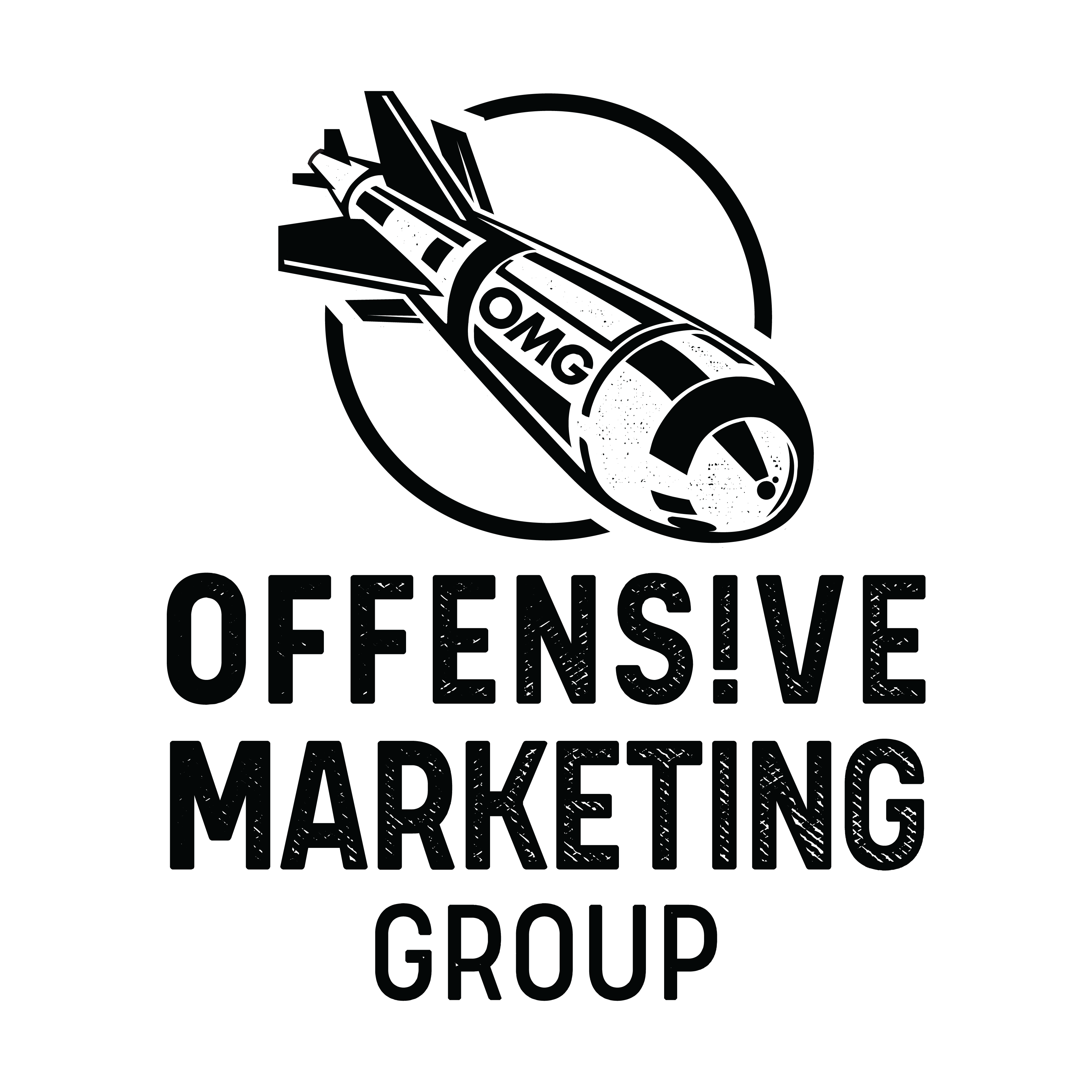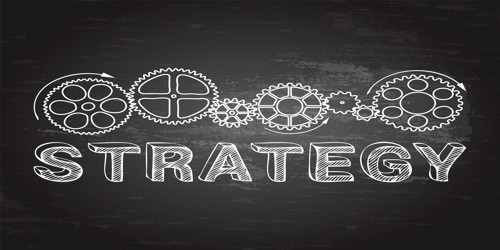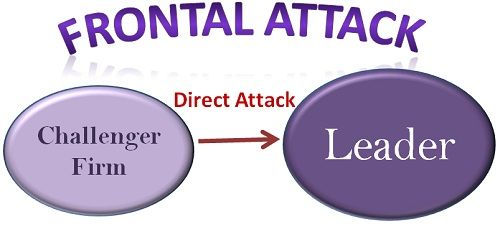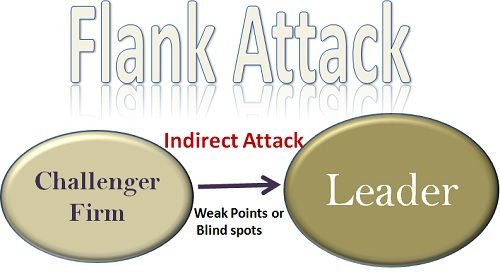Here we are discussing offensive marketing strategy. when a company
When any organization who try to achieve more sale and tries to increase his share, compare to competitors, use offensive marketing strategy. So, The company tries to attention to the weakness of a competitor and tries to accent their strengths.
In this article
What is Offensive marketing?
Offensive marketing strategy is a type of corporate strategy. So, In this strategy, the organization tries to achieve more sales and market share by attacking his competitor.

A company that adopts an offensive marketing strategy invests in the following.
- Invest a high amount on R&D (Research and Development),
- Technology,
- Merger and acquisition and
- Intellectual-property to keep oneself ahead from other competitors.
Due to heavy investment, you can consider this strategy as an expensive strategy.
Inoffensive marketing strategy a different kind of techniques and strategies work either single or in combination with others to create an offensive competitive strategy,
Companies may use entirely different strategies in different marketplace or locales.
Each company has market share, and any company that makes additional efforts to boost its market share compared to competitors by directly attacking the business plan of competitors, and capturing its market is a known offensive marketing strategy.
When one can apply offensive strategy
Organizations can apply this strategy when multiple companies on the market offer the same kind of product; therefore, each company receives only a percentage of all sales of this category of products.

The main purpose of the offensive strategy is to weaken the leader, acquire market share, and a boost in sales.
Some of the offensive strategies with examples are as follows:
Frontal attack:
- In this type, competitor attacks with similar products, price-quality promotion, and distribution. It is highly risky unless the attacker has a clear advantage. Likewise, it is focused on a competitor’s weakness instead of strength.
Pepsi & Coca Cola is the best example of this. Both are from the same category and market leaders in the beverage market. For a long time, they are using this frontal attack strategy against each other. When Pepsi introduced diet Pepsi in the market, Coke introduced diet Coke.

Direct Attack Strategy
- A “Direct Attack Strategy” is a comparatively more aggressive strategy than the end run or preemptive offensive competitive strategies.
- Such a strategy may involve comparisons to competing products or companies that are unattractive, a price war, or even a competition as to who can invite new product features at a faster pace.
End Run Strategy
- An “End Run Strategy” eschews direct competition and instead seeks to develop untouched markets or neglected segments, demographic groups, or areas.
- Companies can attempt to avoid direct competition but still follow an offensive attack by going into unoccupied markets or countries that are ignored completely by the remainder industry.
- A “pre-emptive strategy” is solely the natural advantage a company has when it is the first to serve a selected marketplace or demographic. It can be exceptionally hard to unseat. Also known as the First mover advantage.
- Xerox which invented, and for 15 years dominated, the photocopying industry is the best example
Flank Attack
The flank attack is the marketing strategy that attacking the competitor on the weak point or blind spots. Especially when competitor enjoys a leadership place in the market. It is less risky compare to the previous one.
LG, the other coloured TV producers in India, by launching a rural-specific colour Television “Sampoorna,” thereby becoming the first one to tap the rural areas.
LG demonstrated that Rural Customers aren’t just price-conscious, but they are valued conscious and are ready to pay an affordable premium if the organization delivers a solution to their long-standing problem with their Sampoorna CTV.

Encirclement Attack:
- In this type of strategy, competitor attacks another based on strengths as well as weaknesses and doesn’t leave any stone unturned to overthrow the competition.
The current online e-commerce scenario is the best example of the encirclement attack where the E-commerce companies are ready to compromise their profit margins to thrash a competitor on a turnover basis. They want to come on top and get the highest customers by hook or crook.
Bypass attack:
This strategy is known as the leapfrogging strategy. In this strategy, organizations do innovation in product and bypass the entire product and produce their segment. Though other competitors follow, it is useful for the long term.
Guerrilla marketing:
- In guerrilla marketing, a small brand, which wants to win on huge competitors, first becomes famous in a local market, then introduce price discounts and trade discounts. Guerrilla marketing strategy is very targeted in terms of demographics where they are launched.
Apple, the leading smartphone maker, introduced its I Phone 4S at the end of 2011. People waited in a huge line in front of the Apple store in Australia. At the same time, Samsung, another leading gadget maker, also unveiled it’s smartphone Galaxy S II.
To challenge Apple’s I Phone, Samsung used an aggressive guerrilla marketing strategy. Samsung opened a provisional store near one of the Apple stores. They offered Galaxy S II at AUS $2 to the initial ten customers who were standing in the Que every day. This is the best example of guerilla marketing strategy.
- An acquisition strategy seeks to remove a competitor by buying it. As such, it is a strategy employed by the wealthiest or best-capitalized competitor. Such a strategy offers the advantage of instantly incorporating new markets, customer bases, or corporate intelligence. Since it is such a costly strategy, it must be used wisely, and with the possibility of business antitrust rules or local competition laws in mind.

Defensive Marketing Strategy
Defensive strategies: Defensive strategy is a tactic in which one organization use to retain their customers when a competitor tries to take away their customer from them.
A company uses a defensive marketing strategy by highlighting the effectiveness of their product and try to reduce the risk of financial loss. Firms struggle to take their competition away from the industry.
Defensive Marketing Advantages (when one can use defensive strategy?)
For a well-known company with a wide customer base, defensive marketing is a useful strategy.
- Organizations can adopt these strategies for their existence and for maintaining their position in the market.
- When it comes to adopting a defensive strategy, organizations need to think about what factors separate them from their competitors.
How to implement Defensive Strategies?
Here are some methods that are given to apply this strategy.
- A pricing war, in which a company tries to matching or beating a competitor on price.
- They try to add more features to the product to keep ahead of a competitor.
- The company can offer better service or warranties for their products
- One can emphasize advertising and marketing to boost awareness of improved products or services.
- You can also be partnering with suppliers or retailers to exclude or limit access to competitors.
Following are some regularly used defensive strategies by firms:
- Retrenchment: It consists of the reduction of the expenses by employees’ layoffs to increase profitability. This forces employees to manufacture the company’s products with limited resources or with cheaper raw material.
- Divest: In divest strategy, the company sells some of its assets for higher returns or reduces debts. Generally, companies apply this strategy to invest that capital to create higher future revenue.
- Liquidation: In the Liquidation strategy, the company went into bankruptcy. This situation happened because when the operation and administration of the firm were not right or the managers were not ready enough to control the activities of the firm.
Differences between Offensive and Defensive Marketing
Offensive and defensive marketing strategies have their pros and cons. It depends on the status of your business and how successful you are in your local market.

1A- An offensive strategy provides a means for your new business to hit the market strong and establish a presence,
1B- Whereas, a defensive strategy can help keep you at the top of your local industry.
Offensive competitive strategies try to shape an industry through first-mover and other aggressive moves.
While defensive strategy try to create an image through building brand loyalty, offering high-quality goods, and customer service
Conclusion
Each type of marketing requires careful searching and planning and resource allocation to reach the largest number of consumers.
In this marketing strategy, the organization has to understand two main things
First is their strength and weaknesses
And second is their competitor’s weaknesses and strengths too.
So the first step is to make this strategy is to know the competitor’s strengths and weaknesses.
FAQ’s
any type of company or organization can use this strategy, whether it is a small-medium or large size company. The only requirement is
The organization tries to prove that competitor’s product is cheap and low quality while ours are best and high in quality



